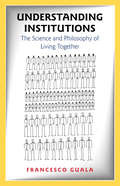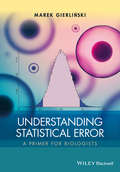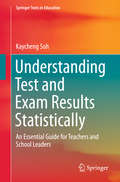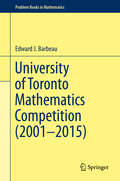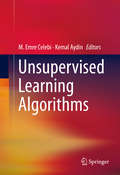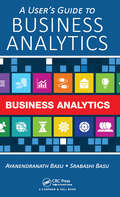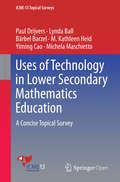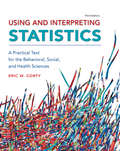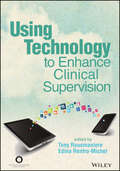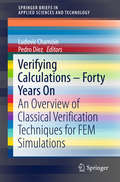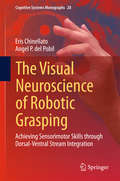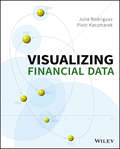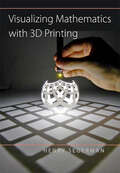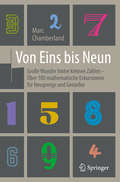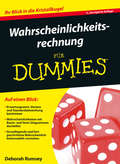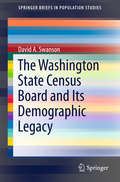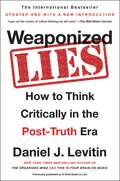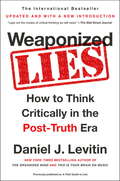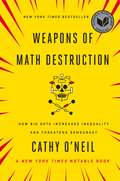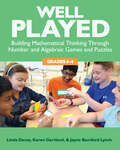- Table View
- List View
Understanding Institutions: The Science and Philosophy of Living Together
by Francesco GualaUnderstanding Institutions proposes a new unified theory of social institutions that combines the best insights of philosophers and social scientists who have written on this topic. Francesco Guala presents a theory that combines the features of three influential views of institutions: as equilibria of strategic games, as regulative rules, and as constitutive rules.Guala explains key institutions like money, private property, and marriage, and develops a much-needed unification of equilibrium- and rules-based approaches. Although he uses game theory concepts, the theory is presented in a simple, clear style that is accessible to a wide audience of scholars working in different fields. Outlining and discussing various implications of the unified theory, Guala addresses venerable issues such as reflexivity, realism, Verstehen, and fallibilism in the social sciences. He also critically analyses the theory of "looping effects" and "interactive kinds" defended by Ian Hacking, and asks whether it is possible to draw a demarcation between social and natural science using the criteria of causal and ontological dependence. Focusing on current debates about the definition of marriage, Guala shows how these abstract philosophical issues have important practical and political consequences. Moving beyond specific cases to general models and principles, Understanding Institutions offers new perspectives on what institutions are, how they work, and what they can do for us.
Understanding Statistical Error
by Marek GierlinskiThis accessible introductory textbook provides a straightforward, practical explanation of how statistical analysis and error measurements should be applied in biological research. Understanding Statistical Error - A Primer for Biologists: Introduces the essential topic of error analysis to biologists Contains mathematics at a level that all biologists can grasp Presents the formulas required to calculate each confidence interval for use in practice Is based on a successful series of lectures from the author's established course Assuming no prior knowledge of statistics, this book covers the central topics needed for efficient data analysis, ranging from probability distributions, statistical estimators, confidence intervals, error propagation and uncertainties in linear regression, to advice on how to use error bars in graphs properly. Using simple mathematics, all these topics are carefully explained and illustrated with figures and worked examples. The emphasis throughout is on visual representation and on helping the reader to approach the analysis of experimental data with confidence. This useful guide explains how to evaluate uncertainties of key parameters, such as the mean, median, proportion and correlation coefficient. Crucially, the reader will also learn why confidence intervals are important and how they compare against other measures of uncertainty. Understanding Statistical Error - A Primer for Biologists can be used both by students and researchers to deepen their knowledge and find practical formulae to carry out error analysis calculations. It is a valuable guide for students, experimental biologists and professional researchers in biology, biostatistics, computational biology, cell and molecular biology, ecology, biological chemistry, drug discovery, biophysics, as well as wider subjects within life sciences and any field where error analysis is required.
Understanding Test and Exam Results Statistically
by Kaycheng SohThis book shares the goal of the classic text How to Lie with Statistics, namely, preventing and correcting statistical misconceptions that are common among practitioners, though its focus is on the educational context. It illustrates and discusses the essentials of educational statistics that will help educational practitioners to do this part of their job properly, i. e. , without making conceptual mistakes. The examples are cast in the school/classroom contexts, based on realistic rather than theoretical examples.
University of Toronto Mathematics Competition (2001-2015)
by Edward J. BarbeauThis text records the problems given for thefirst 15 annual undergraduate mathematics competitions, held in March each yearsince 2001 at the University of Toronto. Problems cover areas ofsingle-variable differential and integral calculus, linear algebra, advancedalgebra, analytic geometry, combinatorics, basic group theory, and numbertheory. The problems of the competitions are given in chronological order aspresented to the students. The solutions appear in subsequent chaptersaccording to subject matter. Appendices recall some background material andlist the names of students who did well. The University of TorontoUndergraduate Competition was founded to provide additional competition experience forundergraduates preparing for the Putnamcompetition, and is particularly useful for the freshman or sophomore undergraduate. Lecturers, instructors,and coaches for mathematics competitions will find this presentation useful. Many of the problems are of intermediatedifficulty and relate to the first two years of the undergraduatecurriculum. The problems presented may beparticularly useful for regular class assignments. Moreover, this text contains problems that lie outside the regular syllabus and may interest studentswho are eager to learn beyond the classroom.
Unsupervised Learning Algorithms
by M. Emre Celebi Kemal AydinThis book summarizes the state-of-the-art in unsupervised learning. The contributors discuss how with the proliferation of massive amounts of unlabeled data, unsupervised learning algorithms, which can automatically discover interesting and useful patterns in such data, have gained popularity among researchers and practitioners. The authors outline how these algorithms have found numerous applications including pattern recognition, market basket analysis, web mining, social network analysis, information retrieval, recommender systems, market research, intrusion detection, and fraud detection. They present how the difficulty of developing theoretically sound approaches that are amenable to objective evaluation have resulted in the proposal of numerous unsupervised learning algorithms over the past half-century. The intended audience includes researchers and practitioners who are increasingly using unsupervised learning algorithms to analyze their data. Topics of interest include anomaly detection, clustering, feature extraction, and applications of unsupervised learning. Each chapter is contributed by a leading expert in the field.
A User's Guide to Business Analytics
by Ayanendranath Basu Srabashi BasuA User's Guide to Business Analytics provides a comprehensive discussion of statistical methods useful to the business analyst. Methods are developed from a fairly basic level to accommodate readers who have limited training in the theory of statistics. A substantial number of case studies and numerical illustrations using the R-software package are provided for the benefit of motivated beginners who want to get a head start in analytics as well as for experts on the job who will benefit by using this text as a reference book. The book is comprised of 12 chapters. The first chapter focuses on business analytics, along with its emergence and application, and sets up a context for the whole book. The next three chapters introduce R and provide a comprehensive discussion on descriptive analytics, including numerical data summarization and visual analytics. Chapters five through seven discuss set theory, definitions and counting rules, probability, random variables, and probability distributions, with a number of business scenario examples. These chapters lay down the foundation for predictive analytics and model building. Chapter eight deals with statistical inference and discusses the most common testing procedures. Chapters nine through twelve deal entirely with predictive analytics. The chapter on regression is quite extensive, dealing with model development and model complexity from a user’s perspective. A short chapter on tree-based methods puts forth the main application areas succinctly. The chapter on data mining is a good introduction to the most common machine learning algorithms. The last chapter highlights the role of different time series models in analytics. In all the chapters, the authors showcase a number of examples and case studies and provide guidelines to users in the analytics field.
Uses of Technology in Lower Secondary Mathematics Education
by Paul Drijvers Lynda Ball Bärbel Barzel M. Kathleen Heid Yiming Cao Michela MaschiettoThis topical survey provides an overview of the current state of the art in technology use in mathematics education, including both practice-oriented experiences and research-based evidence, as seen from an international perspective. Three core themes are discussed: Evidence of effectiveness; Digital assessment; and Communication and collaboration. The survey s final section offers suggestions for future trends in technology-rich mathematics education and provides a research agenda reflecting those trends. Predicting what lower secondary mathematics education might look like in 2025 with respect to the role of digital tools in curricula, teaching and learning, it examines the question of how teachers can integrate physical and virtual experiences to promote a deeper understanding of mathematics. The issues and findings presented here provide an overview of current research and offer a glimpse into a potential future characterized by the effective integration of technology to support mathematics teaching and learning at the lower secondary level. "
Using and Interpreting Statistics
by Eric W. CortyEric Corty's engaging textbook is exceptionally well suited for behavioral science students studying statistical practice in their field for the first time. An award-winning master teacher, Corty speaks to students in their language, with an approachable voice that conveys the basics of collecting and understanding statistical data step by step. Examples come from the behavioral and social sciences, as well as from recognizable aspects of everyday life to help students see the relevance of what they are studying.
Using Technology to Enhance Clinical Supervision
by Tony Rousmaniere Edina Renfro-MichelThis is the first comprehensive research and practice-based guide for understanding and assessing supervision technology and for using it to improve the breadth and depth of services offered to supervisees and clients. Written by supervisors, for supervisors, it examines the technology that is currently available and how and when to use it. Part I provides a thorough review of the technological, legal, ethical, cultural, accessibility, and security competencies that are the foundation for effectively integrating technology into clinical supervision. Part II presents applications of the most prominent and innovative uses of technology across the major domains in counseling, along with best practices for delivery. Each chapter in this section contains a literature review, concrete examples for use, case examples, and lessons learned. *Requests for digital versions from ACA can be found on www.wiley.com. *To request print copies, please visit the ACA website. *Reproduction requests for material from books published by ACA should be directed to permissions@counseling.org
Vanika Kanitham (Business Maths) 11th Standard - Tamilnadu Board
by State Council of Educational Research TrainingVanika Kanitham (Business Maths) Textbook for the 11th Standard Students, preparing for Tamil Nadu State Board Exam.
Vanika Kanitham Thoguthi - I (Business Maths Part I) 12th Standard - Tamilnadu Board
by State Council of Educational Research TrainingVanika Kanitham (Business Maths) Textbook Part I for the 12th Standard Students, preparing for Tamil Nadu State Board Exam.
Vanika Kanitham Thoguthi - II (Business Maths Part II) 12th Standard - Tamilnadu Board
by State Council of Educational Research TrainingVanika Kanitham (Business Maths) Textbook Part II for the 12th Standard Students, preparing for Tamil Nadu State Board Exam.
Variational Methods for Nonlocal Fractional Problems
by Giovanni Molica Bisci Vicentiu D. Radulescu Raffaella ServadeiThis book provides researchers and graduate students with a thorough introduction to the variational analysis of nonlinear problems described by nonlocal operators. The authors give a systematic treatment of the basic mathematical theory and constructive methods for these classes of nonlinear equations, plus their application to various processes arising in the applied sciences. The equations are examined from several viewpoints, with the calculus of variations as the unifying theme. Part I begins the book with some basic facts about fractional Sobolev spaces. Part II is dedicated to the analysis of fractional elliptic problems involving subcritical nonlinearities, via classical variational methods and other novel approaches. Finally, Part III contains a selection of recent results on critical fractional equations. A careful balance is struck between rigorous mathematics and physical applications, allowing readers to see how these diverse topics relate to other important areas, including topology, functional analysis, mathematical physics, and potential theory.
Verifying Calculations - Forty Years On
by Ludovic Chamoin Pedro DíezThis work provides an overview of a posteriori error assessment techniques for Finite Element (FE) based numerical models. These tools aim at estimating and controlling the discretization error in scientific computational models, being the basis for the numerical verification of the FE solutions. The text discusses the capabilities and limitations of classical methods to build error estimates which can be used to control the quality of numerical simulations and drive adaptive algorithms, with a focus on Computational Mechanics engineering applications. Fundamentals principles of residual methods, smoothing (recovery) methods, and constitutive relation error (duality based) methods are thus addressed along the manuscript. Attention is paid to recent advances and forthcoming research challenges on related topics. The book constitutes a useful guide for students, researchers, or engineers wishing to acquire insights into state-of-the-art techniques for numerical verification.
The Visual Neuroscience of Robotic Grasping
by Eris Chinellato Angel P. PobilThis book presents interdisciplinary research that pursues the mutual enrichment of neuroscience and robotics. Building on experimental work, and on the wealth of literature regarding the two cortical pathways of visual processing - the dorsal and ventral streams - we define and implement, computationally and on a real robot, a functional model of the brain areas involved in vision-based grasping actions. Grasping in robotics is largely an unsolved problem, and we show how the bio-inspired approach is successful in dealing with some fundamental issues of the task. Our robotic system can safely perform grasping actions on different unmodeled objects, denoting especially reliable visual and visuomotor skills. The computational model and the robotic experiments help in validating theories on the mechanisms employed by the brain areas more directly involved in grasping actions. This book offers new insights and research hypotheses regarding such mechanisms, especially for what concerns the interaction between the dorsal and ventral streams. Moreover, it helps in establishing a common research framework for neuroscientists and roboticists regarding research on brain functions.
Visualizing Financial Data
by Piotr Kaczmarek Julie RodriguezA fresh take on financial data visualization for greater accuracy and understanding Visualizing Financial Data shows you how to design dynamic, best-of-breed visualizations for better communication of financial data. This book provides a comprehensive set of visualizations tailored to the most common requirements for corporate financial reporting, as well as portfolio, mutual fund, and hedge fund management. This highly visual, full color book showcases a series of cases that push data communication conventions forward, demonstrating and contrasting traditional bar, line, and pie charts against more modern visual methods. The companion website features all of the visualizations discussed, and provides the underlying datasets that you can use to practice on your own or customize the visualizations for your own use. Get a fresh take on visualizations and insight you need to communicate financial data better than ever before. Expand the boundaries of data visualization conventions Optimize data communications, understanding, and disclosure Learn new approaches to traditional charts and visualizations Create exemplary visualizations Visualizing Financial Data shows you newer, better ways of communicating the full meaning of the data, to support efficient, timely, and effective decision-making.
Visualizing Mathematics with 3D Printing
by Henry SegermanThe first book to explain mathematics using 3D printed models.Winner of the Technical Text of the Washington PublishersWouldn’t it be great to experience three-dimensional ideas in three dimensions? In this book—the first of its kind—mathematician and mathematical artist Henry Segerman takes readers on a fascinating tour of two-, three-, and four-dimensional mathematics, exploring Euclidean and non-Euclidean geometries, symmetry, knots, tilings, and soap films. Visualizing Mathematics with 3D Printing includes more than 100 color photographs of 3D printed models. Readers can take the book’s insights to a new level by visiting its sister website, 3dprintmath.com, which features virtual three-dimensional versions of the models for readers to explore. These models can also be ordered online or downloaded to print on a 3D printer. Combining the strengths of book and website, this volume pulls higher geometry and topology out of the realm of the abstract and puts it into the hands of anyone fascinated by mathematical relationships of shape. With the book in one hand and a 3D printed model in the other, readers can find deeper meaning while holding a hyperbolic honeycomb, touching the twists of a torus knot, or caressing the curves of a Klein quartic.
Von Eins bis Neun - Große Wunder hinter kleinen Zahlen
by Marc Chamberland Michael BaslerEine Schatztruhe mathematischer MiniaturenDieses Buch ist eine Einladung zu einer spannenden Entdeckungsreise. Ausgehend von den einstelligen Zahlen eröffnet Marc Chamberland seinen Lesern den Blick auf eine weite mathematische Landschaft. Warum zeigt ein Skatspiel, das man achtmal perfekt gemischt hat, wieder genau dieselbe Kartenfolge? Sind zwei beliebige Menschen auf der ganzen Erde tatsächlich über eine „Bekanntenkette von sechs Personen“ miteinander verbunden? Weshalb lässt sich jede Landkarte mit nur vier Farben so einfärben, dass sich nie zwei Gebiete mit derselben Farbe berühren? Die Zahlen Eins bis Neun erweisen sich als höchst bemerkenswerte mathematische Objekte, von denen aus der Autor ein Netz von Querverbindungen zu verschiedenen Feldern der Mathematik spannt, von der Zahlentheorie über die Geometrie, die Chaostheorie und die numerische Mathematik bis zur mathematischen Physik.Jedes Kapitel ist einer dieser neun Zahlen gewidmet. Zu Beginn stehen stets einfache Problemstellungen; im Verlauf des Kapitels nimmt der Schwierigkeitsgrad zu. Jedes Mal durchstreift Chamberland ein weitläufiges Areal: So ist etwa die Drei ebenso mit der Chaostheorie verknüpft wie mit einem noch ungelösten Problem der ägyptischen Brüche, mit der Anzahl der Aufsichthabenden in einer Kunstgalerie und der Problematik von Wahlergebnissen. Bei der Sieben geht es um Matrizenmultiplikation, die Transsilvanienlotterie, die Synchronisation von Signalen und den Klang einer Trommel. Immer wieder sind auch Rätsel zu lösen wie das der perfekten Quadrate, das Huträtsel oder die Catalan‘sche Vermutung. Das Buch ist in viele kurze Abschnitte unterteilt, die man unabhängig lesen und häppchenweise konsumieren kann – was beim Ham-Sandwich-Satz und beim Pizzatheorem durchaus wörtlich genommen werden darf.Mit den über 100 Miniaturen öffnet der Autor eine wahre mathematische Schatztruhe – für Neugierige und Kenner, für Oberstufenschüler wie für Hochschulstudenten, für gestandene Mathematiker ebenso wie für alle, die von Mustern fasziniert sind.
Wahrscheinlichkeitsrechnung für Dummies (Für Dummies)
by Deborah J. RumseyDie Wahrscheinlichkeitsrechnung wird in der Schule oft nur beiläufig behandelt, dabei handelt es sich um ein besonders spannendes und alltagstaugliches Teilgebiet der Mathematik. Für alle, die über dieses Thema noch etwas mehr erfahren wollen oder müssen, erklärt Deborah Rumsey verständlich und mit Humor, was sie unbedingt wissen sollten. Egal ob Kontingenztabelle, zentraler Grenzwertsatz, Stichproben-, Binomial- oder Poissonverteilung, in diesem Buch lernen Sie, was es ist und wie Sie es anwenden. Zu jedem Kapitel finden Sie online eine Übungsaufgabe samt Lösung, um das Gelernte zu festigen. Auch Tipps zu praktischen Anwendungen - ob bei der Arbeit oder am Pokertisch - kommen nicht zu kurz. So finden Sie in diesem Buch alles, was Sie über Wahrscheinlichkeitsrechnung unbedingt wissen sollten.
The Washington State Census Board and Its Demographic Legacy
by David A. SwansonThis book tells the story of how a group of far-sighted, academic researchers came to the aid of an overwhelmed local government. It details the history of the Washington State Census Board, which began in 1943 as part of an emergency measure during a massive wartime in-migration. The narrative also shows the demographic legacy of the Board and, ultimately, provides an unforgettable look into the creation and evolution of applied demography. Inside, readers will discover how Washington State struggled to keep up with the unexpected needs for housing, transportation, schools, and public utilities for the hundreds of thousands of migrants who came to work in industries that practically developed overnight with the mobilization for World War II. The author recounts how Professor Calvin F. Schmid, who led the Washington State Census Board, and his team developed methods of population estimation that are still in use today. In the process, the narrative reveals how population figures were gathered, compared, and projected at a time when the hand calculator was considered cutting-edge technology. The book also details how methods were refined and improved over time as well as how those involved developed new ways to obtain and, more importantly, utilize the information. With the aid of archived materials, personal interviews, and rich personal accounts, this book will inform and inspir e practicing and academic demographers as well as planners, policy-makers, historians, and interested readers.
Water Histories and Spatial Archaeology
by Michael J. HarrowerThis book offers a new interpretation of the spatial-political-environmental dynamics of water and irrigation in long-term histories of arid regions. It compares ancient Southwest Arabia (3500 BC–AD 600) with the American West (2000 BC–AD 1950) in global context to illustrate similarities and differences among environmental, cultural, political, and religious dynamics of water. It combines archaeological exploration and field studies of farming in Yemen with social theory and spatial technologies, including satellite imagery, Global Positioning System (GPS), and Geographic Information Systems (GIS) mapping. In both ancient Yemen and the American West, agricultural production focused not where rain-fed agriculture was possible, but in hyper-arid areas where massive state-constructed irrigation schemes politically and ideologically validated state sovereignty. While shaped by profound differences and contingencies, ancient Yemen and the American West are mutually informative in clarifying human geographies of water that are important to understandings of America, Arabia, and contemporary conflicts between civilizations deemed East and West.
Weaponized Lies: How to Think Critically in the Post-Truth Era
by Daniel J. LevitinPreviously Published as A Field Guide to Lies We're surrounded by fringe theories, fake news, and pseudo-facts. These lies are getting repeated. New York Times bestselling author Daniel Levitin shows how to disarm these socially devastating inventions and get the American mind back on track. Here are the fundamental lessons in critical thinking that we need to know and share now. Investigating numerical misinformation, Daniel Levitin shows how mishandled statistics and graphs can give a grossly distorted perspective and lead us to terrible decisions. Wordy arguments on the other hand can easily be persuasive as they drift away from the facts in an appealing yet misguided way. The steps we can take to better evaluate news, advertisements, and reports are clearly detailed. Ultimately, Levitin turns to what underlies our ability to determine if something is true or false: the scientific method. He grapples with the limits of what we can and cannot know. Case studies are offered to demonstrate the applications of logical thinking to quite varied settings, spanning courtroom testimony, medical decision making, magic, modern physics, and conspiracy theories. This urgently needed book enables us to avoid the extremes of passive gullibility and cynical rejection. As Levitin attests: Truth matters. A post-truth era is an era of willful irrationality, reversing all the great advances humankind has made. Euphemisms like "fringe theories," "extreme views," "alt truth," and even "fake news" can literally be dangerous. Let's call lies what they are and catch those making them in the act.
Weaponized Lies: How to Think Critically in the Post-Truth Era
by Daniel J. LevitinIt's raining fringe theories, fake news, and pseudo-facts. These lies are getting repeated. New York Times bestselling author Daniel Levitin shows how to disarm these socially devastating inventions and get the American mind back on track. Here are the fundamental lessons in critical thinking (previously published as A Field Guide to Lies) that we need to know and share now. Investigating numerical misinformation, Daniel Levitin shows how mishandled statistics and graphs can give a grossly distorted perspective and lead us to terrible decisions. Wordy arguments on the other hand can easily be persuasive as they drift away from the facts in an appealing yet misguided way. The steps we can take to better evaluate news, advertisements, and reports are clearly detailed. Ultimately, Levitin turns to what underlies our ability to determine if something is true or false: the scientific method. He grapples with the limits of what we can and cannot know. Case studies are offered to demonstrate the applications of logical thinking to quite varied settings, spanning courtroom testimony, medical decision making, magic, modern physics, and conspiracy theories.This urgently needed book enables us to avoid the extremes of passive gullibility and cynical rejection. As Levitin attests: Truth matters. A post-truth era is an era of willful irrationality, reversing all the great advances humankind has made. Euphemisms like "fringe theories," "extreme views," "alt truth," and even "fake news" can literally be dangerous. Let's call lies what they are and catch those making them in the act.
Weapons of Math Destruction: How Big Data Increases Inequality and Threatens Democracy
by Cathy O'NeilLonglisted for the National Book AwardNew York Times BestsellerA former Wall Street quant sounds an alarm on the mathematical models that pervade modern life — and threaten to rip apart our social fabricWe live in the age of the algorithm. Increasingly, the decisions that affect our lives—where we go to school, whether we get a car loan, how much we pay for health insurance—are being made not by humans, but by mathematical models. In theory, this should lead to greater fairness: Everyone is judged according to the same rules, and bias is eliminated.But as Cathy O’Neil reveals in this urgent and necessary book, the opposite is true. The models being used today are opaque, unregulated, and uncontestable, even when they’re wrong. Most troubling, they reinforce discrimination: If a poor student can’t get a loan because a lending model deems him too risky (by virtue of his zip code), he’s then cut off from the kind of education that could pull him out of poverty, and a vicious spiral ensues. Models are propping up the lucky and punishing the downtrodden, creating a “toxic cocktail for democracy.” Welcome to the dark side of Big Data.Tracing the arc of a person’s life, O’Neil exposes the black box models that shape our future, both as individuals and as a society. These “weapons of math destruction” score teachers and students, sort résumés, grant (or deny) loans, evaluate workers, target voters, set parole, and monitor our health.O’Neil calls on modelers to take more responsibility for their algorithms and on policy makers to regulate their use. But in the end, it’s up to us to become more savvy about the models that govern our lives. This important book empowers us to ask the tough questions, uncover the truth, and demand change.— Longlist for National Book Award (Non-Fiction)— Goodreads, semi-finalist for the 2016 Goodreads Choice Awards (Science and Technology)— Kirkus, Best Books of 2016— New York Times, 100 Notable Books of 2016 (Non-Fiction)— The Guardian, Best Books of 2016— WBUR's "On Point," Best Books of 2016: Staff Picks— Boston Globe, Best Books of 2016, Non-Fiction
Well Played, Grades 6-8: Building Mathematical Thinking Through Number and Algebraic Games and Puzzles
by Linda Dacey Karen Gartland Jayne Bamford LynchStudents love math games and puzzles, but how much are they really learning from the experience? Too often, math games are thought of as just a fun activity or enrichment opportunity. Well Played, Grades 6-8: Building Mathematical Thinking Through Number and Algebraic Games and Puzzles shows you how to make games and puzzles an integral learning component that provides teachers with unique access to student thinking. This third book in the series helps you engage students in grades 6-8 in discussions of mathematical ideas and deepen their conceptual understanding. It also helps you develop students' fluency with number systems; ratio and proportional relationships; expressions and equations, statistics and probability; and patterns, graphs, and functions. The twenty-five games and puzzles in Well Played, Grades 6-8 which have all been field-tested in diverse classrooms, contain: Explanations of the mathematical importance of each game or puzzle and how it supports student learning. Variations for each game or puzzle to address a range of learning levels and styles Classroom vignettes that model how best to introduce the featured game or puzzle. The book also includes a separate chapter with suggestions for how to effectively manage games and puzzles in diverse classrooms; game boards, game cards, and puzzles; assessment ideas; and suggestions for online games, puzzles, and apps. Well Played, Grades 6-8 will help you tap the power of games and puzzles to engage students in sustained and productive mathematical thinking.
